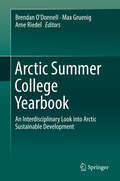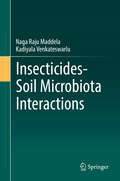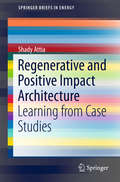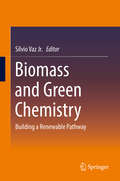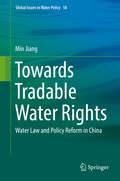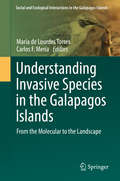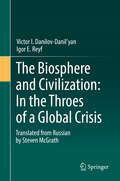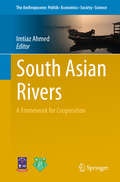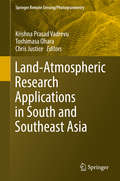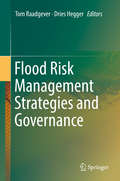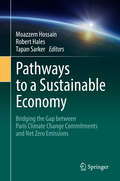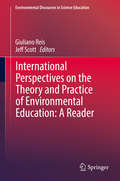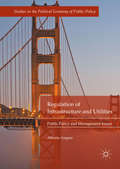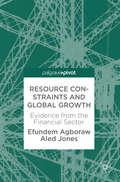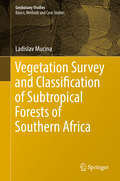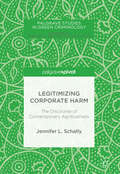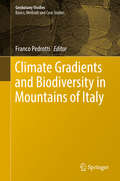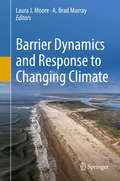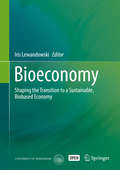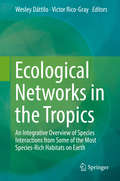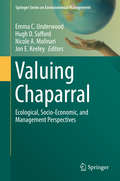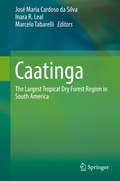- Table View
- List View
Arctic Summer College Yearbook: An Interdisciplinary Look into Arctic Sustainable Development
by Brendan O'Donnell Max Gruenig Arne RiedelThis book highlights both the diversity of perspectives and approaches to Arctic research and the inherent interdisciplinary nature of studying and understanding this incomparable region. The chapters are divided into four liberally-defined sections to provide space for dynamic interpretation and dialogue in search of sustainable solutions to the issues facing the Arctic. From governance to technology, scientific research to social systems, human health to economic development, the authors discuss fundamental questions while looking toward the Arctic’s future. Whether the reader is well-versed in the history and complexity of Arctic policy or looking for an insightful introduction to the vast world of Arctic research, everyone will find answers that lead to new questions and even more discoveries in these pages, laying the foundation for tomorrow’s discussion on the future of the Arctic. The Arctic’s unique geographic and political characteristics pose questions for the international community, indigenous peoples, and economic interests not easily answered through traditional concepts. To that end, the Arctic Summer College has been engaging leading professionals, students, scholars, and policy makers from across the globe to exchange ideas and support further investigation into the Arctic. A joint venture between Ecologic Institute US and Ecologic Institute Berlin (Germany), the College participates at the annual Arctic Circle Assembly in Reykjavik, Iceland, and continues to be at the forefront of international collaboration in this critical area of economic, political, environmental, and humanitarian development.
Insecticides−Soil Microbiota Interactions
by Naga Raju Maddela Kadiyala VenkateswarluThis book provides information about the nontarget nature of selected soil enzymes which are implicated in soil fertility and health and the methods for their assay. It also shows how these soil enzymes are affected by two different pesticides, buprofezin and acephate, used both extensively and intensively in modern agriculture.
Regenerative and Positive Impact Architecture: Learning from Case Studies (SpringerBriefs in Energy)
by Shady AttiaThis book is a guide to energy efficiency and environmental impact assessment in high-performance buildings projects. It compares four state-of-the-art buildings to examine the steps needed for a transition from negative impact reduction architecture to positive impact regenerative architecture, utilizing life cycle analysis. The book provides a solid grounding in the areas of energy-efficient building and building materials life-cycle assessment, discussing carbon efficiency within a wider context that includes its technical, socio-cultural and environmental dimensions and covers the key areas for green buildings performance (operational and embodied energy). The analysis and comparison of four case studies of state-of-art modern building projects in Europe and North America serve as inspiring examples for architects and building professionals in the fields of high performance buildings, ecological materials and carbon efficiency.
Biomass and Green Chemistry: Building a Renewable Pathway
by Sílvio Vaz Jr.This book investigates the main vegetable biomass types, their chemical characteristics and their potential to replace oil as raw material for the chemical industry, according to the principles of green chemistry. Authors from different scientific and technical backgrounds, from industry and academia, give an overview of the state of the art and ongoing developments. Aspects including bioeconomy, biorefineries, renewable chemistry and sustainability are also considered, given their relevance in this context. Furthermore, the book reviews green chemistry principles and their relation to biomass, while also exploring the main processes for converting biomass into bioproducts. The need to develop renewable feedstock for the chemical industry to replace oil has been identified as a major strategic challenge for the 21st century. In this context, the use of different types of vegetable biomass – starch, lignocellulosic, oleaginous, saccharide and algae – can be seen as a viable alternative to the use of non-renewable, more expensive raw materials. Furthermore, it offers a model for adding economic value to the agro industrial chains such as soybean, sugarcane, corn and forests, among others. This will in turn contribute to the sustainability of a wide range of chemicals, mainly organics and their transformation processes, which are widely used by modern society.
Towards Tradable Water Rights: Water Law and Policy Reform in China (Global Issues in Water Policy #18)
by Min JiangThis book provides a first comprehensive legal examination of water rights arrangements and water rights trading in China. Although recent water reform in China has made substantial progress in policy development and practice, how its legal and institutional framework facilitates or hinders the application of tradable water rights remains less addressed in the existing scholarship. Against the backdrop of China’s water reform and the wider international debate in water governance, this book aims to provide an innovative approach to the complex issue of water governance by critically analysing the recent legal and policy developments in China towards tradable water rights. It examines the deficiencies of the current systems for water rights arrangements and trading, explores how China may learn from and build on the international trends in water rights trading practice (mainly Australia and the US), and proposes legal and policy frameworks for defining and administering tradable water rights in China that underpin sustainable water use in the face of exacerbated water scarcity, variability, and uncertainty. All in all, the book proposes pragmatic strategies for China’s water law and policy reform to move towards tradable water rights, which encompasses a comprehensive prescription from initialising and defining tradable water rights to administering water rights and trading. By reflecting on the deepening water reforms in both China and other jurisdictions, the book aims to contribute to the international water governance debate by exploring from a legal and policy perspective, how China, comparative to other cases around the world, can find a balanced combination of water allocation mechanisms to address its water challenges. It is hoped that the observations and proposed implications for China’s water reform will contribute to developing a better understanding of the way in which experiences in water markets can be shared from jurisdiction to jurisdiction.
Understanding Invasive Species in the Galapagos Islands: From the Molecular to the Landscape (Social and Ecological Interactions in the Galapagos Islands)
by María De Torres Carlos F. MenaThis book investigates the introduction of invasive species and their behavior in oceanic islands. How can we define invasive species? What is their history? How did they come to dominate and transform ecosystems? These are relevant questions when trying to understand the behavior of invasive species—primarily in fragile ecosystems such as islands—and to understand the biological, ecological, social and economic impacts of invasions.We chose the Galapagos Islands, a place well-known to be unique in the study of evolution, as a laboratory to analyze the interactions between invasive and endemic species, to understand the makeup of the ecosystems emerging after invasions have occurred, to describe the relationships of invasives with the people that live in these islands, and to try to develop comprehensive analyses on this topic from multi-scalar and multi-disciplinary points of view. For a long time, the discussion has been about how proper management of the species could achieve two main goals: the eradication of the species to recover affected ecosystems and the conservation of endemic species. The discussion has taken on other nuances, including the suggestion that an invasive species, when it is already adapted to an ecosystem, forms an integral part of it, and thus eradication would in itself go against conservation. On the other hand, some invasive species are not only part of the biological compound of the island ecosystems, but they also form part of the social and cultural history of the inhabited islands. Some of these identified by the local inhabitants are species of real or potential economic value.
The Biosphere and Civilization: In the Throes of a Global Crisis
by Victor I. Danilov-Danil'yan Igor E. ReyfThis monograph explores the dire ecological, social, and economic situations facing mankind through comprehensive analyses of global ecological issues, poverty, environmental stability and regulation, and sustainable development. Drs. Victor Danilov-Danil’yan and Igor Reyf discuss the development of ecology as a science, the increasing concern among scientists and public servants for the unsustainability of current economic and demographic trends, and the dire consequences our planet and civilization are already suffering as a result of the ongoing environmental and social crisis. They also address the philosophical implications of the crisis, and suggest possible solutions. The book conveys complex objects of study, namely the biosphere and the harmful anthropogenic processes it has been experiencing for decades, so that the work is accessible without omitting key components of the subject matter. Readers will learn about the social and economic contributors to a threatened biosphere, the mechanisms that maintain the stability of the global environment, and the scales at which sustainable development and preservation can be applied to initiate environmental regulation. Though intended to appeal to the general public and non-specialists, environmental researchers, organizations involved in sustainable development and conservation, and students engaged in ecology, environment, and sustainability studies will also find this book of interest.
South Asian Rivers: A Framework for Cooperation (The Anthropocene: Politik—Economics—Society—Science #21)
by Imtiaz AhmedThis volume identifies existing statist approaches and political economies of river management in South Asia. These rivers are heavily suffering from millions of people who in contrast consider them as holy and worship them. Edited by Professor Imtiaz Ahmed, the contributors of this book from India, Nepal and Pakistan are leading readers on a journey through the transboundary rivers of South Asia where rivers are vital for the life and living. The book explains why the region needs a framework for cooperation on the wellbeing of these rivers. River management is the key to sustaining healthy river systems. The authors stress that right of the rivers must be codified and guaranteed by the state and the people in South Asia. However, the statist approach to the transboundary rivers in South Asia actually conceives them as national rivers. This volume contributes to the current campaign of overcoming the water dystopias in South Asia.
Land-Atmospheric Research Applications in South and Southeast Asia (Springer Remote Sensing/Photogrammetry)
by Krishna Prasad Vadrevu Toshimasa Ohara Chris JusticeThis edited volume sheds new light on the impact of rapid Land Use/Cover Changes (LU/CC) on greenhouse gases (GHG’s) and aerosol emissions in South and Southeast Asia. Several countries in South/Southeast Asia have the highest population growth rates in the world, which is the main cause for LU/CC. Conversion of dense forests to agricultural areas and then to residential and urban areas is most commonly observed in South/Southeast Asian countries with a significant release of GHG’s and aerosols. The book showcases several case studies on the use of remote sensing and geospatial technologies to quantify biomass burning and air pollution impacts, aerosol pollution, LU/CC, and impacts on ecosystem services. The book also includes articles on regional initiatives in research, capacity building, and training. The authors of this book are international experts in the field, and their contributions highlight significant drivers and impacts of air pollution in South/Southeast Asia. Readers will discover the latest tools and techniques, in particular, the use of satellite remote sensing and geospatial technologies for quantifying GHG’s, aerosols and pollution episodes in this region.
Flood Risk Management Strategies and Governance
by Tom Raadgever Dries HeggerThis book points out why organisational or governance aspects are essential for implementing a broad and integrated flood risk management approach. It provides key conclusions on resilient, efficient and legitimate flood risk governance arrangements in vulnerable urban areas in Europe. These are translated into concrete recommendations and good practices that can give you new insights and inspire you to improve policies and practices. The book is a way of spreading the results of the EU 7th Framework Project STAR-FLOOD. The project investigated strategies for dealing with flood risks in 18 vulnerable urban regions in 6 European countries: England, Belgium, France, the Netherlands, Poland and Sweden. STAR-FLOOD focused on governance aspects, from a combined public administration and legal perspective.
Pathways to a Sustainable Economy: Bridging the Gap between Paris Climate Change Commitments and Net Zero Emissions
by Moazzem Hossain Robert Hales Tapan SarkerThe focus of this edited volume is to identify challenges facing organizations in achieving zero greenhouse gas emissions by 2050 and a new energy economy, and to explore solutions from various sectors of the economy to enable the transition to a zero emissions future. Research presented here is divided into three parts, with an introductory statement on growth and sustainability. Part one discusses strategies towards a sustainable economy under a zero emissions goal. Part two contains industry specific case studies focusing on construction and related activities. Part three is devoted to country specific case studies from the Asia-Pacific region. Each of the chapters address one or more of the following issues: restoration, mitigation, adaptation and/or promoting resilience in the face of climate change as part of achieving a sustainable economy. The volume is multi-disciplinary in nature, drawing on various disciplines in social science, business, environment and policy, and will be of interest to UN development agencies, academic institutions, government policy makers, NGOs and business leaders.
International Perspectives on the Theory and Practice of Environmental Education: A Reader (Environmental Discourses in Science Education #3)
by Giuliano Reis Jeff ScottThe present book shares critical perspectives on the conceptualization, implementation, discourses, policies, and alternative practices of environmental education (EE) for diverse and unique groups of learners in a variety of international educational settings. Each contribution offers insights on the authors’ own processes of re-imagining an education in/about/for the environment that are realized through their teaching, research and other ways of “doing” EE. Overall, environmental education has been aimed at giving people a wider appreciation of the diversity of cultural and environmental systems around them as well as the urge to overcome existing problems. In this context, universities, schools, and community-based organizations struggle to promote sustainable environmental education practices geared toward the development of ecologically literate citizens in light of surmountable challenges of hyperconsumerism, environmental depletion and socioeconomic inequality. The extent that individuals within educational systems are expected to effectively respond to—as well as benefit from—a “greener” and more just world becomes paramount with the vision and analysis of different successes and challenges embodied by EE efforts worldwide. This book fosters conversations amongst researchers, teacher educators, schoolteachers, and community leaders in order to promote new international collaborations around current and potential forms of environmental education.This book reflects many successful international projects and perspectives on the theory and praxis of environmental education. An eclectic mix of international scholars challenge environmental educators to engage issues of reconciliation of correspondences and difference across regions. In their own ways, authors stimulate critical conversations that seem pivotal for necessary re-imaginings of research and pedagogy across the grain of cultural and ecological realities, systematic barriers and reconceptualizations of environmental education. The book is most encouraging in that it works to expand the creative commons for progress in teaching, researching and doing environmental education in desperate times.— Paul Hart, Professor of Science and Environmental Education at the University of Regina (Canada), Melanson Award for outstanding contributions to environmental and outdoor education (Saskatchewan Outdoor and Environmental Education Association) and North American Association for Environmental Education (NAAEE)’s Jeske Award for Leadership and Service to the Field of EE and Outstanding Contributions to Research in EE.In an attempt to overcome simplistic and fragmented views of doing Environmental Education in both formal and informal settings, the collected authors from several countries/continents present a wealth of cultural, social, political, artistic, pedagogical, and ethical perspectives that enrich our vision on the theoretical and practical foundations of the field. A remarkable book that I suggest all environmental educators, teacher educators, policy and curricular writers read and present to their students in order to foster dialogue around innovative ways of experiencing an education about/in/for the environment.— Rute Monteiro, Professor of Science Education, Universidade do Algarve/ University of Algarve (Portugal).
Regulation of Infrastructure and Utilities: Public Policy and Management Issues
by Alberto AsquerThis book provides a comprehensive discussion of the public policy and management issues that are encountered in the regulation of infrastructure and utilities. Drawing from theoretical arguments and several case studies, the book is divided into three parts, namely devising regulation, installing regulation, and making regulation work. The first part covers theories of regulation, regulatory policies, strategies and tools, and regulatory reforms. The second part deals with the politics of regulation and regulatory capacity. The third part discusses regulatory commitment and investments, the performance of regulated industries, and the design of regulatory systems. Case studies pay attention to various sectors (including water, electricity, telecommunications, highways, railways, district heating, and airports) from countries in every region of the world. ; ;
Regulation of Infrastructure and Utilities: Public Policy and Management Issues
by Alberto AsquerThis book provides a comprehensive discussion of the public policy and management issues that are encountered in the regulation of infrastructure and utilities. Drawing from theoretical arguments and several case studies, the book is divided into three parts, namely devising regulation, installing regulation, and making regulation work. The first part covers theories of regulation, regulatory policies, strategies and tools, and regulatory reforms. The second part deals with the politics of regulation and regulatory capacity. The third part discusses regulatory commitment and investments, the performance of regulated industries, and the design of regulatory systems. Case studies pay attention to various sectors (including water, electricity, telecommunications, highways, railways, district heating, and airports) from countries in every region of the world. ; ;
Resource Constraints and Global Growth: Evidence from the Financial Sector
by Efundem Agboraw Aled JonesWith substantial risks arising from resource constraints on global growth, serious questions are being posed about how a scarcity of finite resources may impact global social and political fragility. The research which forms the core of this book focuses on how this scarcity will impact the financial sector, especially through insurance, pension and banking activities. The UK finance sector, which is considered to be amongst the most globalised, is placed under the microscope, and its approaches to food and oil are particularly noteworthy. Interviews with senior financial experts are analysed alongside more traditional quantitative economic analysis to explore potential future impacts, the scope of natural resource constraints and their impact on the economy.
Resource Constraints and Global Growth: Evidence from the Financial Sector
by Efundem Agboraw Aled JonesWith substantial risks arising from resource constraints on global growth, serious questions are being posed about how a scarcity of finite resources may impact global social and political fragility. The research which forms the core of this book focuses on how this scarcity will impact the financial sector, especially through insurance, pension and banking activities. The UK finance sector, which is considered to be amongst the most globalised, is placed under the microscope, and its approaches to food and oil are particularly noteworthy. Interviews with senior financial experts are analysed alongside more traditional quantitative economic analysis to explore potential future impacts, the scope of natural resource constraints and their impact on the economy.
Vegetation Survey and Classification of Subtropical Forests of Southern Africa (Geobotany Studies)
by Ladislav MucinaThis book highlights classification patterns and underlying ecological drivers structuring the vegetation of selected indigenous subtropical forests in South Africa. It uses original field sampling and advanced numerical data analysis to examine three major types of forest – Albany Coastal Forests, Pondoland Coastal Scarp and Eastern Scarp – all of which are of high conservation value. Offering a unique and systematic assessment of South African ecology in unprecedented detail, the book could serve as a model for future vegetation surveys of forests not only in Africa, but also around the globe.
Legitimizing Corporate Harm: The Discourse of Contemporary Agribusiness
by Jennifer L. SchallyThis book utilizes critical discourse analysis to illuminate the ways in which one of the largest agribusinesses in operation, Tyson Foods, disguises their actions whilst simultaneously presenting the image of a benign, good corporate citizen. Schally unveils how the discourses employed by Tyson gain legitimacy by drawing on and aligning with larger cultural discourses that are often taken for granted and not adequately scrutinised. This original research, situated at the intersection of green and cultural criminologies, contributes to these current perspectives as well as to the burgeoning social harm approach within criminology. A bold and engaging study, this book will be indispensable for students and scholars of green criminology, corporate crime, animals and society, and environmental sociology, as well as environmental and animal rights activists.
Legitimizing Corporate Harm: The Discourse of Contemporary Agribusiness
by Jennifer L. SchallyThis book utilizes critical discourse analysis to illuminate the ways in which one of the largest agribusinesses in operation, Tyson Foods, disguises their actions whilst simultaneously presenting the image of a benign, good corporate citizen. Schally unveils how the discourses employed by Tyson gain legitimacy by drawing on and aligning with larger cultural discourses that are often taken for granted and not adequately scrutinised. This original research, situated at the intersection of green and cultural criminologies, contributes to these current perspectives as well as to the burgeoning social harm approach within criminology. A bold and engaging study, this book will be indispensable for students and scholars of green criminology, corporate crime, animals and society, and environmental sociology, as well as environmental and animal rights activists.
Climate Gradients and Biodiversity in Mountains of Italy (Geobotany Studies)
by Franco PedrottiThis volume gathers case studies on plant diversity from selected, representative mountain systems of Italy (Mediterranean and temperate zones), while also addressing the biodiversity of avian fauna. For the Alps, Wilhalm and Prosser examine the species biodiversity (also with the help of highly detailed location maps) of the sector of the central Alps that corresponds to the basin of the Adige, including some nearby valleys, between the watershed to the north and the Prealps to the south (Alto Adige and Trentino). In turn, Pedrotti investigates the vegetation series of the same territory in relation to the three climatic sectors identified: prealpine, alpine and endoalpine. Aleffi then explores the relationships between the distribution of a number of species of bryophytes and the main mesoclimatic gradients along a transect through the Valle dell’ Adige between 46°40'N and 45°42'N. Lastly, Siniscalco studies the ways in which alien species are now invading the western Alps, which to date have remained largely unaffected by this phenomenon, unlike the plains and hills. For the Apennines, Ferrari studies the tree line and the biodiversity of the vegetation of the northern Apennines; for the mountains of Sicily, Bazan conducts a diachronic analysis of the beech forests of the Monti Nebrodi. The contribution by Venanzoni interprets the chorology of associations of the Magnocaricetalia order throughout Italy, relating it to the climatic and geographic gradients. He describes a total of 55 associations, reporting on the distribution in the temperate zone (differentiating between the alpine and continental) and the Mediterranean zone for each of them. Cianfaglione presents the Signal Project Italian site. This project investigates the effects of extreme weather events on secondary grassland and the role of selected alien species, mowing, biodiversity, productivity and functional traits, in Italy and along a European gradient. For the Marches Region, Forconi describes the biodiversity of the avian fauna in relation to the altitudinal gradient and the potential vegetation.
Barrier Dynamics and Response to Changing Climate
by Laura J. Moore A. Brad MurrayThis book presents chapters, written by leading coastal scientists, which collectively depict the current understanding of the processes that shape barrier islands and barrier spits, with an emphasis on the response of these landforms to changing conditions. A majority of the world’s population lives along the coast at the dynamic intersection between terrestrial and marine ecosystems and landscapes. As narrow, low-lying landforms, barriers are especially vulnerable to changes in sea level, storminess, the geographic distribution of grass species, and the rate of sand supply—some barriers will undergo rapid changes in state (e.g., from landward migrating to disintegrating), on human time scales. Attempts by humans to prevent change can hasten the loss of these landforms, threatening their continued existence as well as the recreational, financial and ecosystem service benefits they provide. Understanding the processes and interactions that drive landscape response to climate change and human actions is essential to adaptation. As managers and governments struggle to plan for the future along low-lying coasts worldwide, and scientists conduct research that provides useful guidance, this volume offers a much-needed compilation for these groups, as well as a window into the science of barrier dynamics for anyone who is generally interested in the impacts of a changing world on coastal environments.
Bioeconomy: Shaping the Transition to a Sustainable, Biobased Economy (Economic Complexity And Evolution Ser.)
by Iris LewandowskiThis book is open access under a CC BY 4.0 license.This book defines the new field of "Bioeconomy" as the sustainable and innovative use of biomass and biological knowledge to provide food, feed, industrial products, bioenergy and ecological services. The chapters highlight the importance of bioeconomy-related concepts in public, scientific, and political discourse. Using an interdisciplinary approach, the authors outline the dimensions of the bioeconomy as a means of achieving sustainability.The authors are ideally situated to elaborate on the diverse aspects of the bioeconomy. They have acquired in-depth experience of interdisciplinary research through the university’s focus on “Bioeconomy”, its contribution to the Bioeconomy Research Program of the federal state of Baden-Württemberg, and its participation in the German Bioeconomy Council.With the number of bioeconomy-related projects at European universities rising, this book will provide graduate students and researchers with background information on the bioeconomy. It will familiarize scientific readers with bioeconomy-related terms and give scientific background for economists, agronomists and natural scientists alike.
Ecological Networks in the Tropics: An Integrative Overview of Species Interactions from Some of the Most Species-Rich Habitats on Earth
by Wesley Dáttilo Victor Rico-GrayBased on graph theory studies this book seeks to understand how tropical species interact with each other and how these interactions are affected by perturbations in some of the most species-rich habitats on earth. Due to the great diversity of species and interactions in the tropics, this book addresses a wide range of current and future issues with empirical examples and complete revisions on different types of ecological networks: from mutualisms to antagonisms. The goal of this publication is not to be only for researchers but also for undergraduates in different areas of knowledge, and also to serve as a reference text for graduate-level courses mainly in the life sciences.
Valuing Chaparral: Ecological, Socio-Economic, and Management Perspectives (Springer Series on Environmental Management)
by Emma C. Underwood Hugh D. Safford Nicole A. Molinari Jon E. KeeleyChaparral shrubland ecosystems are an iconic feature of the California landscape, and a highly biodiverse yet highly flammable backdrop to some of the fastest growing urban areas in the United States. Chaparral-type ecosystems are a common element of all of the world’s Mediterranean-type climate regions – of which California is one – yet there is little public appreciation of the intrinsic value and the ecosystem services that these landscapes provide. Valuing Chaparral is a compendium of contributions from experts in chaparral ecology and management, with a focus on the human relationship with chaparral ecosystems. Chapters cover a wide variety of subjects, ranging from biodiversity to ecosystem services like water provision, erosion control, carbon sequestration and recreation; from the history of human interactions with chaparral to current education and conservation efforts; and from chaparral restoration and management to scenarios of the future under changing climate, land use, and human population. Valuing Chaparral will be of interest to resource managers, the research community, policy makers, and the public who live and work in the chaparral dominated landscapes of California and other Mediterranean-type climate regions.
Caatinga: The Largest Tropical Dry Forest Region in South America
by José Maria Silva Inara R. Leal Marcelo TabarelliThis book provides in-depth information on Caatinga’s geographical boundaries and ecological systems, including plants, insects, fishes, amphibians, reptiles, birds, and mammals. It also discusses the major threats to the region’s socio-ecological systems and includes chapters on climate change and fast and large-scale land-use changes, as well as slow and small-scale changes, also known as chronic human disturbances. Subsequent chapters address sustainable agriculture, conservation systems, and sustainable development. Lastly, the book proposes 10 major actions that could enable the transformation of Caatinga into a place where people and nature can thrive together. “I consider this book an excellent example of how scientists worldwide can mobilize their efforts to propose sound solutions for one of the biggest challenges of modern times, i.e., how to protect the world’s natural ecosystems while improving human well-being. I am sure this book will inspire more research and conservation action in the region and perhaps encourage other groups of scientists to produce similar syntheses about their regions.” Russell Mittermeier, Ph.D. Executive Vice-Chair, Conservation International
